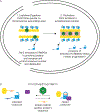PCH-2 and meiotic HORMADs: A module for evolutionary innovation in meiosis?
- PMID: 36681475
- PMCID: PMC10947530
- DOI: 10.1016/bs.ctdb.2022.07.001
PCH-2 and meiotic HORMADs: A module for evolutionary innovation in meiosis?
Abstract
Sexual reproduction and the specialized cell division it relies upon, meiosis, are biological processes that present an incredible degree of both evolutionary conservation and divergence. One clear example of this paradox is the role of the evolutionarily ancient PCH-2/HORMAD module during meiosis. On one hand, the complex, and sometimes disparate, meiotic defects observed when PCH-2 and/or the meiotic HORMADS are mutated in different model systems have prevented a straightforward characterization of their conserved functions. On the other hand, these functional variations demonstrate the impressive molecular rewiring that accompanies evolution of the meiotic processes these factors are involved in. While the defects observed in pch-2 mutants appear to vary in different systems, in this review, I argue that PCH-2 has a conserved meiotic function: to coordinate meiotic recombination with synapsis to ensure an appropriate number and distribution of crossovers. Further, given the dramatic variation in how the events of recombination and synapsis are themselves regulated in different model systems, the mechanistic differences in PCH-2 and meiotic HORMAD function make biological sense when viewed as species-specific elaborations layered onto this fundamental, conserved role.
Keywords: Homologous chromosomes; PCH2; Pachytene checkpoint; Pch2; Recombination; Synapsis; TRIP13.
Copyright © 2023 Elsevier Inc. All rights reserved.
Figures



References
-
- Balboni M, Yang C, Komaki S, Brun J, & Schnittger A (2020). COMET Functions as a PCH2 cofactor in regulating the HORMA domain protein ASY1. Current Biology, 30(4113–4127), e4116. - PubMed
-
- Baudat F, Manova K, Yuen JP, Jasin M, & Keeney S (2000). Chromosome synapsis defects and sexually dimorphic meiotic progression in mice lacking Spo11. Molecular Cell, 6, 989–998. - PubMed
-
- Bhalla N, & Dernburg AF (2005). A conserved checkpoint monitors meiotic chromosome synapsis in Caenorhabditis elegans. Science, 310, 1683–1686. - PubMed

